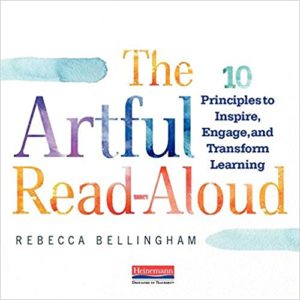Ten Principles of Artful Read-Alouds
The Artful Read-Aloud: 10 Principles to Inspire, Engage, and Transform Learning
By Rebecca Bellingham
(Heinemann, 2020 – Learn more)

I love reading. Leaving home without a book is as unthinkable to me as leaving without my wallet, phone, or keys. And yet, I’ve had a hard time sustaining a read-aloud with my middle school classes. It was with this in mind that I picked up The Artful Read-Aloud by Rebecca Bellingham.

However, as I returned to The Artful Read-Aloud each evening, I realized what a powerful tool read-alouds are in uncertain times. Stories connect us across time and distance. And so, the first video I recorded for my students was a read-aloud. And, I realized, though I read with fluency and expression I still have a lot to learn.
Bellingham builds her book around “10 Principles of the Artful Read-Aloud” including “Embody the Text,” “Look Up,” and “Invite Conversation.” Each principle highlights several tips illustrated with examples and photographs.
Artifacts from read-alouds including anchor charts, graphic organizers, and annotated sections of text help readers engage with examples. Bellingham draws from her experience reading aloud to students, coaching work she’s done with teachers, and her careers as an actress and literary coach.
Beyond ELA
While Bellingham shows how reading aloud supports Reading and Writing Workshop, she also moves beyond the English/Language Arts classroom.
For example, in Principle Seven: “Be Awed,” Bellingham suggests “dazzling” students. “Using a picture book to launch units in science, social studies, and other content areas is a perfect tool for igniting their interest and giving them some background knowledge right away” (p. 91).
Last fall, I began Jacqueline Woodson’s Brown Girl Dreaming with a class of sixth graders in a personal narrative unit. One of my pitfalls was modeling all my thinking as I read. As I began to read one day, a student asked “can you just read?” “And not do all that talking?” I finished for him. Humbled, I let Woodson’s beautiful work speak for itself. So I appreciated the time Bellingham took to consider the balance of reading and discussion.
After finishing The Artful Read-Aloud, I began reading Pam Muñoz Ryan’s Mañanaland. I found myself reading differently as I looked for opportunities to engage students while still creating the space for the story to take center stage.
In Principle Four: “Look Up,” Bellingham suggests “by making kids your scene partners, you heighten the drama, but you also give kids access to the nuances inside the scene” (p. 59). As I read, I looked for those places to slow down and invite conversation, realizing they needed to be carefully chosen.
Bellingham provides tools to support classroom discussion including tips and prompts that can be transferred to discussions outside of the read-aloud as well. One gem is a table of questions organized by bands of text complexity (p. 68). Many of her prompts and strategies can be applied more broadly to classroom discussion such as “resisting the urge to confirm correctness” (p. 50) coupled with strategies for guiding students who need support in their understanding.
Beyond day-to-day preparation
Teachers can also find strategies to help guide their preparation, such as a list of “Questions about making meaning to keep in mind as you read children’s literature” (p.38), strategies for fueling your own reading life, and a thoughtfully curated list of read aloud texts (Children’s Literature Cited p. 152).
Bellingham drew me in most successfully when she showed her own learning journey, doubt, and growth – as she does in the section “Take a Breath.” She writes that being busy “is something I’m working on, as a person and a friend, definitely as a mom and always as a teacher.”
At other times, her writing seems self-congratulatory which, unfortunately, is reinforced by nearly two dozen color photos of the author at work. For example, when introducing a quote from personal correspondence, she writes, “I have a lot of friends who are working actors. I have known Alison Cimmet since our college days when we performed in shows like Into the Woods together” (p. 45).
Deeply thoughtful and empathetic
Other aspects of the book, however, are deeply thoughtful and empathetic. When discussing how read-alouds help teachers connect with all students and level the playing field for students who are reading below grade-level, Bellingham notes that “reading aloud always makes it possible for me to love my kids back up, even the ones who are in pesky moods or full of trouble on any given day” (p.60).
In Principle Eight, “Dig Deep: Promoting equity, action, and change,” Bellingham examines how to support “a pedagogy of social justice” through read-alouds by making “room for complicated conversations where [her] perspective is limited.” She provides strategies for reading challenging sections of text in a way that acknowledges the discomfort and makes space for students to process their responses.
I recently took a deep breath and began reading Mañanaland out loud to my students through a series of Google Meets and pre-recorded videos. During the first chapter, I paused twice to give students a chance to respond. Instead of a turn and talk, student responses scrolled through the chat window. As I closed the book, I recognized the look on students’ faces. One that showed me for a moment, at least, they’d traveled to another place, reminding me that indeed, reading aloud is a “source of comfort, connection, and ultimately love” (p. 61).
Jeny Randall, a Responsive Classroom certified teacher, teaches 6th grade Language Arts and science at Saratoga Independent School in New York State. As Middle School Coordinator, she oversees the curriculum and program development for grades 6 – 8. Outside of school Jeny teaches yoga, reads whatever students send her way, and spends time with her family, outside if possible.


































